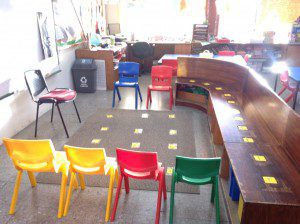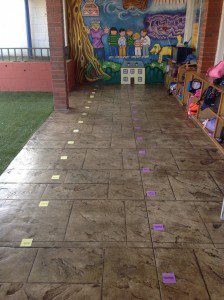One of the most impactful teaching strategies identified by John Hattie is teachers forging strong relationships with their students. This is because good teacher-student relationships are the fundamental basis for successful behaviour management. In fact, anything you can do to build a good teacher-student relationship will work in your favour when it comes to behaviour management. This can include showing a genuine interest in your students’ personal hobbies, getting involved in extra-curricular activities or simply keeping up-to-date with the latest trends.
There are many excellent books and other resources already devoted to behaviour management, so I will only outline the most successful approaches to the topic here. Nevertheless, I have included here some common-sense strategies that have worked for me and countless numbers of other teachers who I have met. These strategies serve to both help foster a strong relationship with students and manage poor behaviour from students when it takes place.
To talk about successful teaching and not consider behaviour management would be downright short-sighted. Yet, it still surprises me just how little attention is given to behaviour management on teacher training courses. Effective behaviour management is the single most important foundation for successful teaching, and is perhaps the most overlooked. Managing behaviour well is, after all, key to creating an environment in which teaching and learning can flourish, as well as helping students to understand about socially acceptable and appropriate choices. Without effective behaviour management, teaching becomes a much more stressful job. Statistics on teacher retention, for example, make for sober reading. Almost half of new teachers entering the profession leave within their first five years, and half of them cite poor behaviour from students as one of the reasons.
Successful teachers teach not just the curriculum, but also social and emotional skills. This of course, goes hand in hand with effective behaviour management. Managing behaviour well is a key ingredient for cultivating a sense of competency on the part of teachers, leading to confidence for the teacher in his or her abilities, and a more satisfying career.
Managing behaviour well requires three overlapping qualities: emotional competence, an understanding of human thinking and organisation.
Emotional Competence
Managing behaviour is an emotional skill; it requires training yourself to think and act in a certain way, which for most of us, goes against how we would instinctively respond to poor behaviour from students. This means that when a child misbehaves, you do not lose your temper and you show emotion only sparingly. Likewise, you do not use rewards or prizes in an attempt to manipulate children to meet your minimum expectations, i.e. simply for behaving well. While such approaches may work in the short-term, the long-term costs are too high. Neither losing your temper nor giving out rewards helps children to build respectful relationships with adults or with one another.
As a classroom teacher, your emotions should communicate high expectations of students in terms of both their achievement and behaviour. Accordingly, for example, your tone of voice should be a calm, neutral and assertive tone – which communicates that you are in control and you will get what you expect. Your body language is equally important. Move around the classroom naturally and purposefully (like you own it), standing tall and exerting a conscious effort to make eye contact with each and every learner. You should work to cultivate a strong sense of inner calm, remaining unfazed even when things go wrong.
There are three key characteristics of an emotionally competent teacher:
- An emphasis on positive statements rather than negative statements., e.g. “We’ve got some exciting activities to do today.” Do your best to frame everything you say in a positive light even when students make mistakes. Highlighting the success of students (rather than focusing on mistakes) helps to build both their self-esteem and your relationship with them. In particular, by looking for and focusing on those children who are behaving as you want, you are likely to get more of that type of positive behaviour.
- Regular and sustained use of praise, e.g. “As per usual, you’re working incredibly quietly Class 5, well done!”
- Teaching students the social skills they need to be successful. Use ‘I expect…’ statements, to set children positive behaviour targets, e.g. “I expect you to show respect for everyone in our class, paying full attention when someone else is speaking.” Communicating clear expectations, and sharing these regularly with your class, is a key part of successful behaviour management. This is particularly important in your first few lessons with a new class, when you will need to define boundaries about what is acceptable and unacceptable behaviour.
When you display such characteristics in your teaching, you are also more likely to have your students’ full engagement. This is because emotional competence and ensuring full engagement on the part of your students go hand in hand; it is impossible to have one without the other.
In order to cultivate this emotional competence, it is necessary to regulate your internal dialogue and emotions. The words from the influential book ‘The Power of Positive Thinking’ by Norman Vincent Peale (1996 [1953], pp. 16-17), are relevant here: ‘Feelings of confidence depend on the type of thoughts that habitually occupy your mind. Think defeat and you are bound to be defeated… Formulate and stamp indelibly on your mind a mental picture of yourself as succeeding.’ By regulating your emotions in such a way, you will be able to project what Derington & Goddard (2008) refer to as ‘resolute optimism’, which is contagious and has an energising impact on those around you:
‘The teacher who enters a classroom in a warm, appreciative and enthusiastic manner with obvious high expectation is likely to have this reflected back by the students.’ (Derrington & Goddard, 2008, pp. 27).
Just like a muscle, maintaining resolute optimism requires constant training, to begin each day with a positive frame of mind. The power of one’s internal monologue cannot be overstated. All personal development is based on moving our inner voice away from self-criticism and negativity to a more positive and affirming self-talk. As Beck et al. (2003) point out, this approach is grounded in a well-known cognitive therapy technique and psychotherapeutic practice in which individuals learn how to distinguish between realistic and maladaptive thinking.
One of the fundamental messages from Dave Burgess’s book (2012), Teach Like a Pirate, is the importance of exuding passion as a way to fuel student engagement. An interesting and insightful point that Dave Burgess makes is that this passion need not necessarily come from a love of the subject matter itself – instead, it can just come from professional or personal passion alone:
‘For example, I mentioned that I am not passionate about railroads. Fortunately for my students, I am passionate about developing engaging presentations for my material. So, although I might not be jazzed about the subject, I can absolutely be inspired and fully engaged in my attempt to present the topic in an entertaining way.’ (Burgess, pp. 12, 2012).
Finding ways to incorporate your passions into your teaching practice will energise you, ensuring that you can create powerful and engaging lessons, which are more likely to be remembered by students.
Of course, when it comes to energy levels you also need to look after yourself. This means taking up physical exercise after work to help relieve stress, getting plenty of rest and making sure that you stay well hydrated. I would also recommend being careful to manage your time well. It can be easy to fall into the trip of saying ‘yes’ to every demand on your time, particularly at the beginning of your teaching career (this is a mistake I certainly made early on), e.g. the student council, extra-curricular activities, fundraising projects, etc. However, it is important that you learn to politely say ‘no’ in order to avoid too many demands being placed on your time. By doing so, you will free up energy to focus on what is most important – your teaching.
Understanding how Humans Think
Developing the emotional skill of behaviour management also requires a basic understanding of how humans think – the things humans do to avoid what they dislike, and to get things they like. This understanding should be used by teachers to create an intelligent system of appropriate praise and sanctions, which motivates children to behave well because it feels good to do so. There are many options here to create such a system, including point systems, marbles in a jar, extra playtime and so on. One of my favourite strategies is to phone home, to share some positive comments about the child. This works particularly well for those students who are keen to please his or her parents.
It is worth remembering too that children will follow the role model that you set for them. If you say please and thank you all the time, for instance, then even without realising it, the children in your class will emulate your politeness and good manners. From my own experience, I have found that establishing a climate of good manners helps tremendously in terms of building a cohesive and positive classroom. Everything that you say and do should exemplify the expectations that you have of your students.
By virtue of mimicking behaviour, if you get into a habit of shouting regularly, to get children’s attention, then they will learn to shout too. This in turn tends to lead to a noisier working environment, which will only serve to heighten your stress levels and theirs. As far as possible then, in times when you need to get children’s attention, use non-verbal signals, for instance:
- Raising your hand in the air;
- Ringing a bell;
- Clapping three times.
Once children become accustomed to the expectations you have associated with your chosen non-verbal signal(s), these should become hard-wired into their subconscious. It should feel as though you are using a magic wand every time you use your chosen non-verbal signal, as a sense of calm and quiet should quickly descend across the classroom.
In terms of your actual teaching delivery, as obvious as it may sound, unless the subject matter is delivered in an interesting way, children will quickly lose concentration. As a rough guide, Sue Cowley (2012, pp. 24) suggests that children can concentrate for their age plus 2. So, a five-year-old will only be able to concentrate for approximately seven minutes on one activity. Even within these short timeframes, it is still necessary to ensure that you do your best to hold the children’s attention.
Among the many options at your disposal to do this, your best tool is actually your voice itself. You should aim to vary the tone and pitch of your voice, putting emphasis on key words. By doing so, you will hold students’ attention for much longer. By contrast, a monotone voice will quickly lead to boredom and misbehaviour in the classroom. The teacher, Christopher Emdid makes an excellent demonstration of this point, in his TED Talk, ‘Teach teachers how to create magic’. In my own experience, I have also found that sudden, unexpected pauses in the middle of a sentence helps to keep a certain suspense, which serves to make your teaching delivery more gripping.
While on the subject of teacher voice, you should keep what you have to say to an absolute minimum. This applies both to your teaching delivery and any general instructions that you need to give. It is worth mentioning incidentally, that this can be one of the biggest challenges for some teachers, especially those who love the sound of their own voices! Simply put, the less you say, the easier it is for your students to assimilate, remember and act on what you have said. Conversely, the longer you talk, the more likely you will lose students, and after too long hearing you’re the sound of your voice, they will inevitably phase out, become bored and then misbehave.
Organisation
Irrespective of what a child’s home life might be like, the classroom should become a home away from home with predictable routines and structured activities. It is within this environment that children should know the boundaries for acceptable and unacceptable behaviour. For students, this can provide a much-needed sense of consistency and stability.
This requires first and foremost that you explain to your students the basics, for example, of how you expect the children to enter the room, line up, leave the classroom and so on. It may well be necessary to walk through every single detail of classroom procedure, especially for younger students. If you are new to teaching, notes or an outline before the beginning of each new school day will help you to internalise the classroom procedures for yourself. By having all your expectations very clear in your own mind, you will be much quicker to identify and respond appropriately to any poor behaviour.
Seating plans are an effective way to help you demonstrate organisation and keep control of a class. As well as helping you to learn students’ names at the beginning of the academic year, it sends a signal that you are organised, orderly and in charge. As shown in the photos, Post-It notes are an ideal size to mark out seating arrangements. For younger children (8 years and below), I would use them on the carpet (for the introductory part of a lesson, plenary or story time) and on the floor outside the classroom to indicate where children should sit when lining up. This simply helped save time as well, as the children knew straightaway where to sit. The Post-It notes do inevitably wear away after a few weeks (even after taping them into place), but students will remember the seating plan well before then.
An online behaviour management system such as Class Dojo can help you to further organise your classroom by providing a point system, which fosters positive student behaviours and a positive classroom culture. It is also a great way to get parents involved, helping to ensure that they are not only aware of their child’s behaviour, but also have an idea of all the good work their child is producing.
Likewise, it should go without saying that lessons need to be planned thoroughly. All students should be appropriately challenged with meaningful lesson activities and have extra tasks to move onto if they finish the main piece of work set. Even before lessons begin, it helps to have a calming activity for students when they first enter your room such as word problems or maths puzzles. The key idea here is to make sure that there is as little downtime as possible, as students should always have something constructive to do.
All that being said, when positive influence and organisation fails to maintain student behaviour – which occasionally it will – it is then necessary to manage the negative choices that students make. This should be done by following through with clearly defined consequences that follow a hierarchy. Although there is not a neat step-by-step method that fits all situations or all children, you should have in mind (and on display) a clear sequence of pre-planned consequences to carry out in the event of a student who misbehaves.
Assuming low-level behaviour issues (e.g. shouting out when the teacher is talking), below is a suggested sequence:
- The first time a student misbehaves, give a warning and/or loses a class point.
- The second time the student misbehaves, s/he will move seats.
- The third time the student will miss 10-minutes of breaktime.
- The fourth time the student will miss all of breaktime.
- If the behaviour issues continue after this point, then a meeting with the parents/caregivers should be arranged.
There are a whole range of different sanctions that can be applied, such as loss of privileges, detentions, phone calls/emails to parents and so on. The important point is that your sanctions should start at a low level, and gradually build up if the student continues to defy you. Common sense is obviously required here and this sequence will need to be adapted for the situation at hand. In the event of a student who physically harms another student or swears in class for example, you would undoubtedly escalate directly to steps 4 and 5 in this sequence. Remember, whatever the situation, do your best to remain relentlessly calm and polite, which makes confrontations with students less likely to occur.
Concluding thoughts…
It should be clear by now that, while in the presence of your students, behaviour management itself is a full-time job. Fortunately, it is a skill that we can practise, and after a while, it becomes second nature. Working to incorporate the strategies discussed will help to develop your qualities of emotional competence, your understanding of how humans think and your organisational skills – which all serve to help you manage behaviour well.





